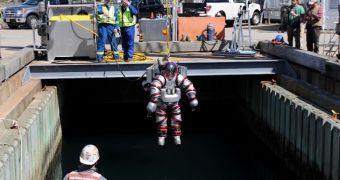Should things go according to plan, it will only be a few months until a state-of-the-art diving suit and one really lucky explorer wearing it plunge in the waters off the coast of Antikythera, an island in Greece, and come face to face with a 2,000-year-old shipwreck.
The suit, a photo of which is available above, is chiefly made of metal and packs several 1.6-horsepower thrusters that the folks who developed it expect will help it reach the shipwreck without too much trouble.
According to Live Science, this state-of-the-art diving suit is the most advanced that has until now been pieced together by researchers and marine exploration specialists. Besides, it is nothing short of impressive size-wise.
Thus, the suit weighs an impressive 530 pounds (approximately 240 kilograms) and stands about 6.5 feet (2 meters) tall. One can only assume that the person who is going to put it on later this year will have to be fairly strong to handle it.
The same source tells us that, before being used to explore the 2,000-year-old shipwreck resting off the coast of Antikythera, the suit will serve to study natural ecosystems off the coast of Rhode Island.
This first mission is expected to take place sometime this coming July. If all goes well, the diving suit will be shipped to Greece and used to explore the sea floor in this part of the world a couple of months later, in September.
Information shared with the public says that the ship whose remains researchers and divers wish to poke around this coming September sank sometime around the year 50 BC. It is believed that, when it sank, it was carrying loads of gold jewelry.
Besides, rumor has it that the vessel was also transporting bronze and marble statues, together with scientific instruments. Simply put, the shipwreck might be hiding one really impressive treasure. One that divers and researchers hope to recover, that is.
“Our eyes light up thinking about it. It's the kind of thing that wakes you up in the middle of the night. These are artifacts that have never been seen since the time of Caesar,” Brendan Foley with the Woods Hole Oceanographic Institute in Massachusetts said in an interview.
By the looks of it, the ship's scattered remains cover an area that measures about 130 feet (40 meters) in length and 33 feet (10 meters) in width. The shipwreck was first discovered back in 1900, and has not been disturbed for decades.

 14 DAY TRIAL //
14 DAY TRIAL //